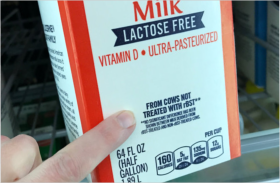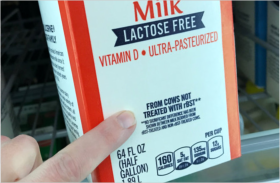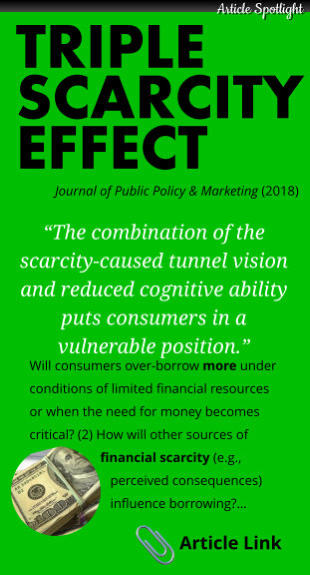Laurel-Cook.com





Why Do We Twitch? Vicarious Consumption in Video-Game Livestreaming (link)
Journal of Consumer Marketing
Using a mixed-method approach, this research examines vicarious consumption (VC) via the video-game streaming platform
Twitch. We empirically show how VC leads to unique outcomes that differ from active consumption (AC). In VC, negative
outcomes experienced by Person 1 (i.e., someone who is engaging in AC) may be attenuated for Person 2 (i.e., someone
who is engaging in VC). For example, riding a roller coaster can cause greater fear
than watching. Additionally, unfavorable outcomes for Person 1 may become
favorable for Person 2 (e.g., watching someone lose a game may cause mirthful
enjoyment), thus enhancing positive outcomes. We also demonstrate the moderating
effect of familiarity on mood change.
Sharenting in an Evolving Digital World: Increasing Online Connection and
Consumer Vulnerability (link)
Journal of Consumer Affairs
Sharenting (using social media to share content about one’s child) is a progressively
common phenomenon enabled by society’s increased connection to digital
technology. Although it can encourage positive connections to others, it also creates
concerns related to children’s privacy and well-being. In this paper, we conceptualize a
modern sharenting ecosystem involving key stakeholders (parents, children,
community, commercial institutions, and policymakers). We also expand the
characterization of sharenting by introducing a spectrum of sharenting awareness
that categorizes three types of sharenting (active, passive, and invisible).
Consumer Effort in Service Encounters: Effort as Formative Construct and the
Overlooked Impact of Emotional Posing (link)
Journal of Services Marketing
This paper cautions marketers about the potential negative implications of shadow
work. Service marketers should provide a choice between face-to-face (F2F) and self-
service technologies (SSTs) whenever possible. In addition, marketers should develop
and implement strategies for reducing consumer surface acting.
Reducing Referral Leakage: An Analysis of Health Care Referrals in a Service Ecosystem (link)
Journal of Services Marketing
In this research, we address a critical problem for health care organizations: patient referral leakage. This paper explores
the nature of patient referrals by examining how health care providers’ breadth and depth of connectivity within a hospital
network and identification with each other influence the likelihood of future patient referrals.
Intercollegiate Social Media Education Ecosystem (link)
Journal of Marketing Education
The popularity of social media among students and practitioners has encouraged marketing educators to find ways to
incorporate it into their classrooms. We offer results from an intercollegiate collaboration (#ICMKTG) that provides an
innovative learning environment through a social media education ecosystem (SMEE).
Consumer Perceptions of Genetically Modified Foods: A Mixed-Method Approach (link)
Journal of Consumer Marketing
This research examines consumers’ opinions and behavioral intentions toward foods labeled as containing genetically
modified (transgenic) ingredients across plant and animal-based categories. In light of marketplace changes (i.e., labeling
requirements) we explore behavioral measures based on labeling options.
Conceptualizing the Multiple Dimensions of Consumer Financial Vulnerability (link)
Journal of Business Research
This review draws across disciplines to consolidate extant knowledge on financial vulnerability. First, we propose a novel
definition of financial vulnerability that includes both its subjective and objective dimensions. Next, we create a framework
to assess a consumer's financial vulnerability. We then identify interventions for varying degrees of financial vulnerability
that are tailored to the individual's fiscal situation. Finally, we present a research agenda to guide future research on
financial vulnerability.
Product Knowledge and Information Processing of Organic Foods (link)
Journal of Consumer Marketing
This research examines how product knowledge influences consumers to consider available information before choosing
between organic and non-organic options. Since “certified organic” is based on a complex standard in the United States,
many consumers have only partial understanding of the term. Our research shows how that knowledge influences
consumer evaluation of the options presented in the market.
Making Inconsistent Worlds: A Conceptual Framework for Co-Competition in Service Dominant Logic (link)
Journal of Consumer Marketing
This research addresses the conflict that occurs when segmentation does not play a strategic role in the new product
development (NPD) process. Self-segregated groups of consumers are co-creatively involved in NPD, but may have
contradictory product goals. We explore the outcome, co-competition, here.
Effects of Perceived Scarcity on Financial Decision-Making (link)
Journal of Public Policy & Marketing
Internal influences (including perceived consequences) and external influences (including decreased lending options) lead
to results described in this article as the “triple scarcity effect.” Experimental results show how perceived financial scarcity
undermines loan decisions, particularly for consumers at the greatest financial risk. Next, qualitative data collected from
the Consumer Financial Protection Bureau are used for a between-method triangulation of the earlier findings.
Understanding the multidimensionality of perceived financial scarcity is important for designing preventive measures that
improve decisions (e.g., not reborrowing) and decision making (e.g., accurately calculating cost). Results from two
interventions demonstrate how these improvements are made when consumers' perceptions of scarcity are reduced.
Nutrition Labeling Research in the United States: Consumer Processing, Message Structure & Moderating
Conditions (link)
Oxford Encyclopedia of Health and Risk Message Design and Processing
Several unanswered research questions remain regarding how the proposed changes to the nutrition fact panels
(NFPs)—beef, poultry, and seafood labeling; restaurant chain calorie labeling; alternative FOP formats; and regulated and
unregulated health and nutrient content claims—will affect consumers.
Health Belief Model and Healthy Consumption: Toward an Integrated Model (link)
Journal of Food Products Marketing
Even before food consumption takes place, the human brain can be persuaded by the body’s senses in an extremely
dramatic and influential way. Contextual cues in a variety of settings can then motivate consumers to engage in non-
homeostatic appetitive behavior. Recognizing and understanding the role of these secondary reinforcers in behavior,
therefore, is essential in creating new solutions for consumers most vulnerable to these influences.
The Credibility of ‘Locally Grown’ Community-Supported Agriculture: Priorities and Perspectives of Consumers
Institute of Food Products Marketing
The “alternative” food marketplace that has emerged in response is populated by labels such as certified organic, free-
range, Kosher, natural, GMO-free, nitrate free, and, increasingly, locally grown. Our focus, then, is to examine “locally grown”
through the lens of community-supported agriculture. We evaluate the extent to which consumers who join CSAs expect
that they are part of a locally grown culture, and how perceptions of locally grown influence the credibility of CSAs.
Broken Halos and Shattered Horns: Overcoming the Biasing Effects of Prior Expectations through Objective
Information Disclosure (link)
Journal of the Academy of Marketing Science
The relationship between health halos and potential increases in unhealthy food consumption has received considerable
attention from consumer health and welfare researchers. We suggest the inverse effect also deserves broader
consideration. We label this understudied contrasting bias the “health horn” effect, an erroneous negative inference that
occurs when a product is mistakenly perceived to be unhealthy.
Overview of the Job Market Process (link)
AMA Transitions Guide: Navigating the Progression from Doctoral Student to Marketing Professor
The process of applying for a job as an assistant professor of marketing is as exciting as it is nerve-wracking.
In response, this guide is offered to help prepare you and to provide the perspective of others who have gone through the
process. In this section, we provide an overview of the job market to illustrate how the process typically begins, develops,
and concludes.
Leaner Choices? The Potential Influence of the Inclusion of Nutrition Facts Panels on Consumer Evaluations and
Choices of Ground Beef Products (link)
Journal of Public Policy & Marketing
Results of three studies (a cross-sectional survey and two between-subjects experiments) indicate that the inclusion of a
Nutrition Facts panel (NFP) on ground beef packaging moderates the effects of the lean-to-fat ratio on consumers’ product
evaluations. The authors offer potential implications of the findings for policy and consumer welfare.
Health Risk Factors and Their Effect on Consumers’ Use of Nutrition Facts Panels (link)
Journal of Consumer Affairs
The authors present results with more than 2,600 participants aged 45 or older that show the following: 1) consumers
diagnosed with both high blood pressure and high cholesterol are significantly more likely to access sodium and cholesterol
NFP information than consumers with either only one of these conditions or neither condition, and 2) there are few
differences in attention to somewhat less well-publicized, but relevant nutrients. The results show a greater need for at-risk
consumers to attend to the somewhat less familiar, or perhaps less understood, negative (e.g. trans fat) and positive
nutrients (fiber) associated with their specific health condition.
Articles and Book Chapters

Designed and built by Laurel Aynne Cook
© Laurel Aynne Cook 2024
HEALTH CARE REFERRALS
We offer a novel view of referral relationships
using hard-to-access proprietary data.
Moreover, this research responds to the need
for transformative service research by offering
researchers a means to enhance consumer well-
being. We offer a framework to better
understanding patient referral relationships
between health care providers in an
organization, thereby affording an opportunity
to bolster operational efficiencies, improve
clinical outcomes, and strengthen referral
pathways. By viewing health care networks
through a service ecosystems perspective,
contextual boundaries and the relative power of
relationships are also identified. The novel use
of rarely available hospital data in this setting
helps explain how patient leakage compromises
the health of the ecosystem and its members.
INTERCOLLEGIATE TWEETS
One of the most successful applications of
Twitter in the classroom involves using the
platform to reinforce material learned within the
course. we offer results from an intercollegiate
collaboration that provides an innovative
learning environment through a Twitter-based
marketing education ecosystem (MEE).
Participating students discuss current marketing
topics with peers, marketing practitioners, and
faculty to reinforce concepts, improve learning
perceptions, and increase professional
communication skills and networking
opportunities. Results from (A) Twitter analytics,
(B) student data, and (C) Linguistic analysis
suggest that students improved their
professional communication skills while using
language that provokes greater cognitive
processes. Wanna join us? Let me know :)

FINANCIAL VULNERABILITY
Financial vulnerability (FV) is often considered
a problem affecting the poor or uneducated,
though in reality, even the wealthy can be
financially vulnerable. In many cases, consumers
don’t know they are financially vulnerable. For
example, 74% of Americans report that they are
financially stable (Federal Reserve, 2018); yet
most households do not have sufficient savings
to handle an unexpected emergency and
maintain their living standards (Pew Charitable
Trusts, 2017). There is a clear disconnect
between an individual's perception (i.e.,
subjective) of their financial situation and their
actual (i.e., objective) state. In contrast with
extant research, we offer a more inclusive
conceptualization of FV by taking on a holistic
perspective comprising both subjective and
objective dimensions.

Select Research in Progress


Training & Certifications


Collaborative Institutional Training Initiative (CITI) Social & Behavioral Responsible Conduct of Research (No Expiry;
certificate)
CITI Human Research Refresher Training (Expires October 2026; certificate)
CITI Conflicts of Interest Training (Expires February 2024; certificate)
CITI Human Research Basic Training (Expires January 2025; certificate)
Mediation, Moderation, and Conditional Process Analysis: 5-day course taught by Dr. Andrew F. Hayes with an emphasis on
the use of PROCESS for SPSS and SAS (July 2015 Completion; Course Link)
Confirmatory Factor Analysis and Structural Equation Modeling: Workshop taught by Dr. Barry J. Babin
(November 2017 Completion)
Grant Proposal Writing: Workshop taught by Dr. John D. Robertson (June 2017 Completion)
Amazon MTurk “Trusted Academic Requesters and Researchers” listing, managed by Niloufar Salehi
(Social Computing Ph.D. Candidate at Stanford University).

EMPATHY APPEALS IN PSAs
A recent trend in public service advertising
suggests that empathy tactics are more effective
than fear appeals in reaching communicative
goals. This strategy seems counter to the
academic literature that posits that respondents
pay more attention to and more easily process
negative rather than positive events and
messages. This study addresses the question of
whether a low-fear appeal is sufficient when
employing empathy coupled with a fear appeal;
the study investigates the moderating effect of
fear appeals—low versus high—on public service
announcements with empathy in their messaging.
Results suggest that high-fear appeals have a
stronger effect on ad claim beliefs’ influence on
conative outcomes. Practical implications of the
findings are discussed.

MISLEADING LABELS?
“No Antibiotics” or “Antibiotic Free” labeling
on a milk carton may suggest different things
to a consumer. One inference may suggest
that some milk contains antibiotics.
Alternatively, another inference may suggest
that antibiotics in milk is unfavorable and
products without them are superior. However,
such labels can be deceiving since all milk
currently sold in U.S. grocery stores is
technically antibiotic-free. Here, we specifically
examine a situation that breeds information
asymmetry, misinformation, and creates a
significant burden to producers. With
marketplace practices outpacing regulatory
intent, consumers who rely on product labels
to inform their choices may be unknowingly
vulnerable.

MESSAGING INEFFECTIVENESS
STD rates in the U.S. are at a record high
(31.4%) for the eighth consecutive year (CDC
2018a). The Director of the CDC’s Division of STD
Prevention, Dr. Gail Bolan, says it is now “…a
critical time for STD prevention. We need bold
ideas” (CDC 2018b). My coauthors and I have
responded to the CDC’s call for more research in
this area with an agenda designed to address
health messaging ineffectiveness. Importantly, our
research will specifically examine effects for the
“special focus profiles” that the CDC has
highlighted as populations who are particularly
vulnerable to the nation’s changing health
landscape. These groups include (A) adolescents,
(B) racial minorities, and (C) the LGBTQ community.
The CDC has also identified (D) people aged 55
and older as a unique at-risk group.















Articles and Book Chapters

Select Research in Progress


EMPATHY APPEALS IN PSAs
A recent trend in public service advertising
suggests that empathy tactics are more effective
than fear appeals in reaching communicative
goals. This strategy seems counter to the
academic literature that posits that respondents
pay more attention to and more easily process
negative rather than positive events and
messages. This study addresses the question of
whether a low-fear appeal is sufficient when
employing empathy coupled with a fear appeal;
the study investigates the moderating effect of
fear appeals—low versus high—on public service
announcements with empathy in their
messaging. Results suggest that high-fear
appeals have a stronger effect on ad claim
beliefs’ influence on conative outcomes. Practical
implications of the findings are discussed.

MISLEADING LABELS?
“No Antibiotics” or “Antibiotic Free” labeling
on a milk carton may suggest different things
to a consumer. One inference may suggest
that some milk contains antibiotics.
Alternatively, another inference may suggest
that antibiotics in milk is unfavorable and
products without them are superior. However,
such labels can be deceiving since all milk
currently sold in U.S. grocery stores is
technically antibiotic-free. Here, we specifically
examine a situation that breeds information
asymmetry, misinformation, and creates a
significant burden to producers. With
marketplace practices outpacing regulatory
intent, consumers who rely on product labels
to inform their choices may be unknowingly
vulnerable.

MESSAGING INEFFECTIVENESS
STD rates in the U.S. are at a record high
(31.4%) for the eighth consecutive year (CDC
2018a). The Director of the CDC’s Division of STD
Prevention, Dr. Gail Bolan, says it is now “…a
critical time for STD prevention. We need bold
ideas” (CDC 2018b). My coauthors and I have
responded to the CDC’s call for more research in
this area with an agenda designed to address
health messaging ineffectiveness. Importantly,
our research will specifically examine effects for
the “special focus profiles” that the CDC has
highlighted as populations who are particularly
vulnerable to the nation’s changing health
landscape. These groups include (A) adolescents,
(B) racial minorities, (C) the LGBTQ community,
and (D) people aged 55 and older.


HEALTH CARE REFERRALS
We offer a novel view of referral relationships
using hard-to-access proprietary data. Moreover,
this study responds to the need for
transformative service research by offering
researchers a means to enhance consumer well-
being. The main contribution of this study is a
framework to gain a better understanding of
patient referral relationships between employees
(i.e., health care providers) in an organization,
thereby affording an opportunity to bolster
operational efficiencies, improve clinical
outcomes, and strengthen referral pathways. By
viewing health care networks through a service
ecosystems perspective, contextual boundaries
and the relative power of relationships are also
identified. The novel use of rarely available
hospital data in this setting helps explain how
patient leakage compromises the health of the
ecosystem and its members.


INTERCOLLEGIATE TWEETS
One of the most successful applications of
Twitter in the classroom involves using the
platform to reinforce material learned within the
course. we offer results from an intercollegiate
collaboration that provides an innovative
learning environment through a Twitter-based
marketing education ecosystem (MEE).
Participating students discuss current marketing
topics with peers, marketing practitioners, and
faculty to reinforce concepts, improve learning
perceptions, and increase professional
communication skills and networking
opportunities. Results from (A) Twitter analytics,
(B) student data, and (C) Linguistic analysis
suggest that students improved their
professional communication skills while using
language that provokes greater cognitive
processes. Wanna join us? Let me know :)


FINANCIAL VULNERABILITY
Financial vulnerability (FV) is often considered
a problem affecting the poor or uneducated,
though in reality, even the wealthy can be
financially vulnerable. In many cases, consumers
do not even know they are financially vulnerable.
For example, 74% of Americans report that they
are financially stable (Federal Reserve, 2018); yet
most households do not have sufficient savings
to handle an unexpected emergency and
maintain their living standards (Pew Charitable
Trusts, 2017). There is a clear disconnect
between an individual's perception (i.e.,
subjective) of their financial situation and their
actual (i.e., objective) state. In contrast with
extant research, we offer a more inclusive
conceptualization of FV by taking on a holistic
perspective comprising both subjective and
objective dimensions. This inclusive
conceptualization is a much-needed addition to
the consumer finance literature

 Full list of publications included on my CV
Full list of publications included on my CV
















